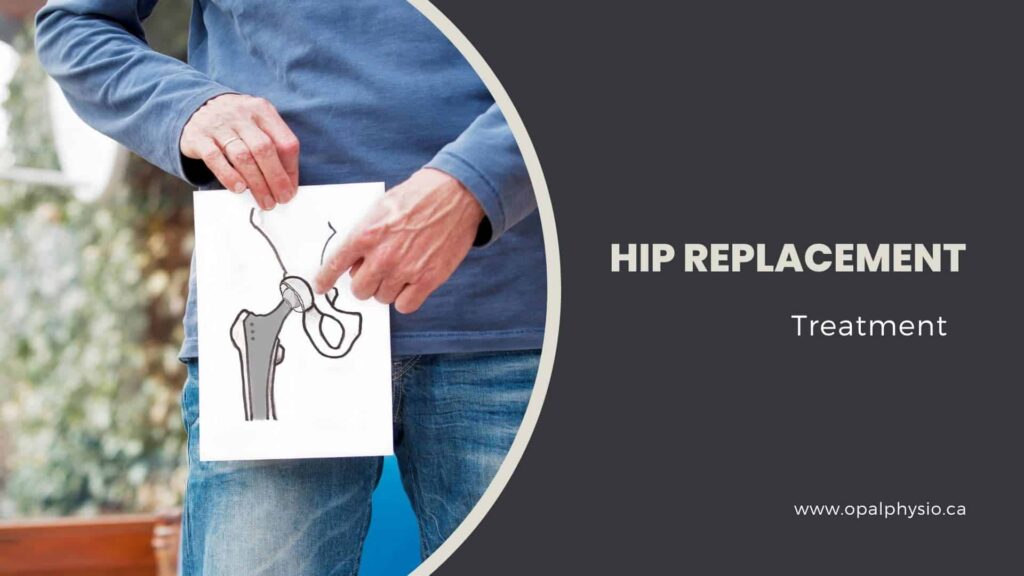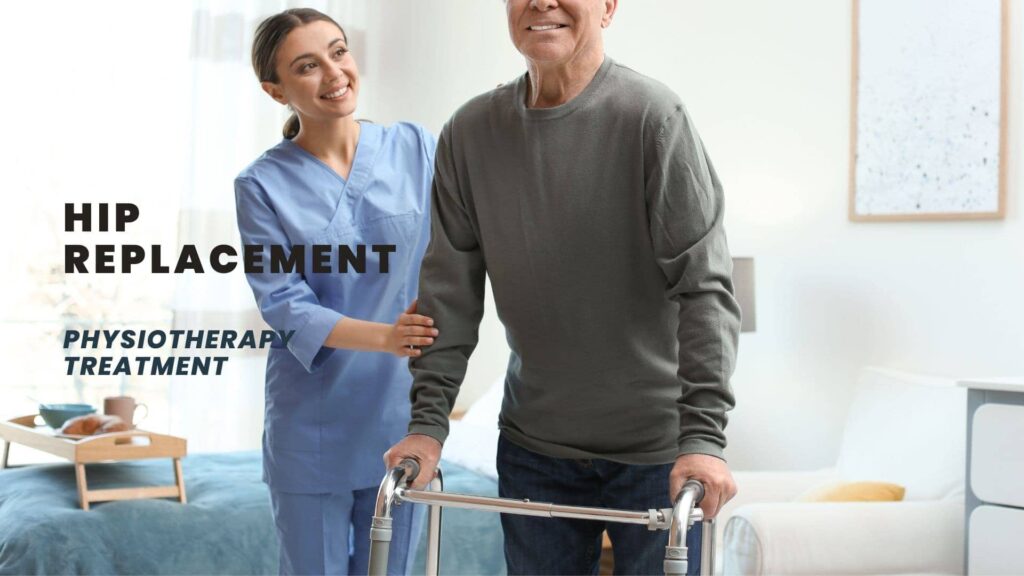Hip Replacement
A hip replacement is a standard surgical procedure where a damaged hip joint is replaced with an artificial implant. During the surgery, the head of the femur is removed and replaced by a metal ball and socket that fits into the acetabulum.
Hip replacement surgery is an effective treatment for arthritis in hip joints to help relieve pain when all other conservative management has been ineffective. Hip replacement is also done to treat fractures, hip dysplasia, avascular necrosis, rheumatoid arthritis or other causes of pain or hip deformity.
Hip Replacement Physiotherapy Treatment
Physiotherapy treatment is an essential part of your recovery after a hip replacement. Our well-trained orthopedic physiotherapists at Opal Physio Langley help reduce your hip pain and improve your range of motion, strength, flexibility and mobility post-surgical. We aim to help patients recovering from replacement of hip surgery restore movement and function.

Types of hip replacement :
Your orthopedic surgeon will determine whether hip replacement surgery and what type is the best method to relieve pain and improve your mobility.
There are three main approaches to accessing the hip joint during replacement surgery:
- Posterior approach: The most common method where the incision is made on the back/rear side of the hip.
- Anterior approach: Incision made on the front of the hip. It may allow quicker recovery and less muscle damage.
- Lateral approach: Incision made on the outer side of the hip.
There are also different components used to replace the damaged hip joint.
- Total hip replacement: Both the ball (femoral head) and socket (acetabulum) are replaced—a common type of hip replacement surgery.
- Partial hip replacement: Only the ball portion is replaced. It may be an option for younger patients.
- Hip resurfacing: Damaged bone and cartilage are removed and replaced with a smooth metal covering. This procedure is less invasive than total hip replacement.
The implants used in hip replacement are typically made of metal, plastic, and/or ceramic.
The appropriate type of hip replacement depends on factors like age, activity level, bone quality, surgeon’s expertise, and reason for the joint damage.
Hip replacement treatment for joints
Physiotherapy rehabilitation is provided following a hip post-surgical protocol and precautions to help you return to normal functioning at the earliest. Rehabilitation is usually provided immediately after surgery while in the hospital to help prevent scar tissue build-up and improve range of motion, strength and mobility using gait aids.
After your discharge from the hospital, our physiotherapists at Opal Physiotherapy Clinic can help you with your ongoing rehabilitation and help you gain full recovery. First, our experienced physiotherapists will do an initial evaluation, including your strength and range of motion and follow up with a rehabilitation treatment plan.

Benefits of physiotherapy after hip replacement surgery
Physiotherapy plays a crucial role in the rehabilitation process after a replacement of hip. Our expert physiotherapists work closely with patients to:
- Reduce pain and swelling around the hip joint
- Regain range of motion and flexibility of the new hip joint
- Build strength, especially in the gluteal and thigh muscles
- Improve balance and stability
- Restore normal gait patterns and movement
- Return to activities of daily living and hobbies
Most patients experience significant improvements in hip mobility, muscle strength, and overall function with regular physiotherapy within the first few months after surgery.
Our hip replacement rehab program in Langley
We tailor our hip replacement rehab program to each patient’s needs, goals, and recovery rate. A typical program may include:
Early post-op exercises
Exercises may start the same day or the day after surgery
- Ankle pumps to improve circulation, quad sets, glute sets, heel slides
- Gentle hip and knee range of motion exercises
- Low-impact cardio like walking or stationary cycling.
Exercises are done under the guidance of a physiotherapist and with weight-bearing precautions to protect the new hip joint.
Intermediate exercises
After hospital discharge, outpatient physiotherapy continues two times per week. The goals are to improve strength, flexibility, and gait and return to normal activities.
Exercises progress from non-weight bearing (e.g. leg raises) to partial weight-bearing (e.g. mini squats), then full weight-bearing exercises.
Gait re-training after hip surgery is an integral component of rehabilitation. It helps reduce any muscle imbalance and walking abnormalities that could persist after surgery and helps you return to walking without any gait deviations.
Advanced exercises
- Single-leg stands, lateral step-downs
- Agility drills and sport-specific training
Our physiotherapists continuously monitor your progress and adjust the program as needed. Rehabilitation typically continues for 3-6 months after surgery.
Usually, post-hip replacement recovery treatment may take up to 12 weeks for the pain and swelling to reduce and return to regular activities. However, note that it may take up to a year for a full recovery and to get back to feeling normal,
Long-term exercise recommendations:
- Continue regular exercises at home to maintain strength and mobility
- Avoid high-impact activities like running to prevent excessive wear on the hip implant
- Low-impact activities like walking, swimming, cycling are encouraged
- Seek guidance from your surgeon and physiotherapist regarding safe exercises and activities after hip replacement.
Early mobilization and physiotherapy rehabilitation are crucial for optimal recovery after total hip replacement surgery. Exercises post replacement of hip progress over 3-6 months from non-weight bearing to full activity to restore strength, mobility, and function. Long-term exercise is encouraged to maintain a healthy, active lifestyle.
Don’t struggle alone with recovery after hip replacement surgery. Our skilled physiotherapists develop personalized rehab programs to help you regain function fast. Book an appointment or call us today to learn more!
